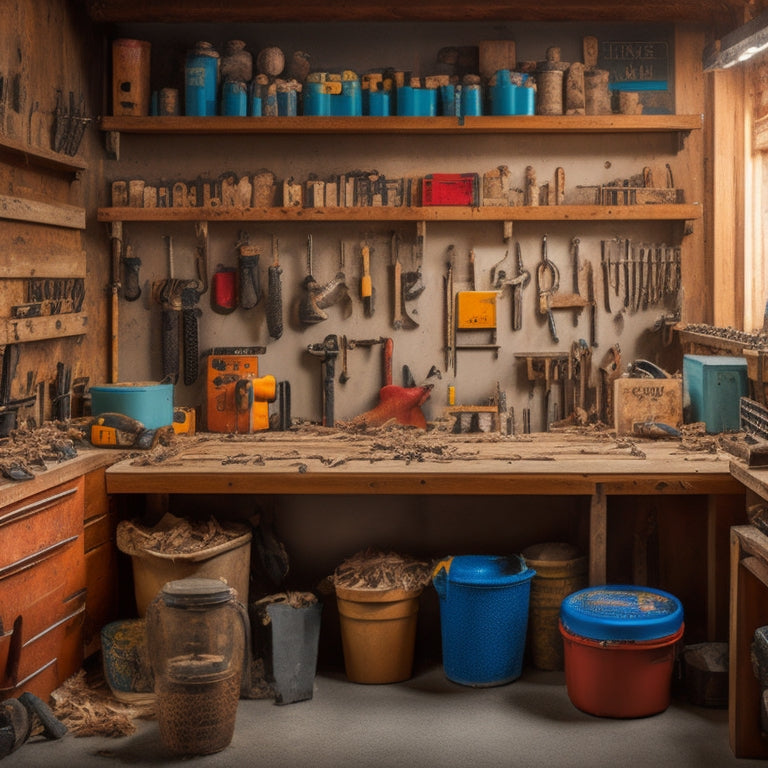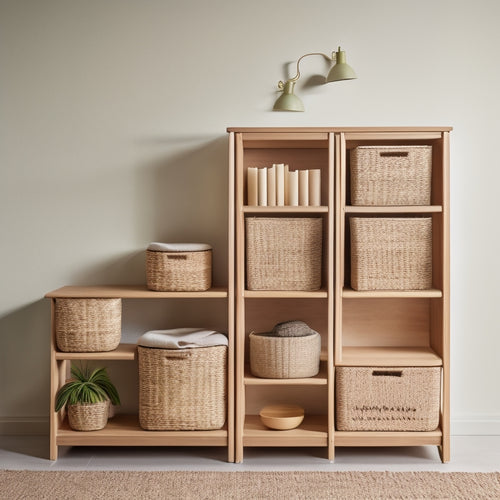
Why Woodworkers Need a Solid Tool Organization System
Share
You need a well-planned tool organization system to reveal the full potential of your woodworking workshop. A solid system helps you maximize space efficiency, reduce tool loss and misplacement, and boost productivity. By streamlining your workflow, you'll minimize frustration and stress, and customize your system to fit your unique needs. With a well-organized tool collection, you'll enjoy benefits like facilitated maintenance, reduced downtime, and enhanced safety and accessibility. By implementing a solid tool organization system, you'll discover how to get the most out of your tools, and now it's time to explore the specifics of how to make it happen.
Key Takeaways
• A well-organized tool system saves time and reduces frustration by eliminating tool loss and misplacement, allowing woodworkers to focus on high-priority tasks.
• A solid tool organization system boosts productivity and speed by streamlining workflow, making data-driven decisions, and optimizing the workspace for maximum efficiency.
• Customizing a tool organization system to fit unique woodworking projects and styles enhances project efficiency, reduces stress, and increases overall performance.
• A well-organized tool collection facilitates maintenance tasks, enables proactive issue identification, and improves overall productivity, leading to increased revenue.
• Proper tool storage and accessibility enhance safety, reduce downtime, and protect tool investment, ultimately leading to a more successful woodworking business.
Maximizing Workshop Space Efficiency
You frequently find yourself grappling with cluttered workbenches and congested aisles, which can hinder your workflow and stifle your creativity. To overcome this, prioritizing space optimization and tool organization in your workshop is crucial. By doing so, you'll be able to maximize your workshop's efficiency and create a more productive setting.
Begin by evaluating your current layout design and pinpointing areas that can be enhanced. Consider the frequency of use for each tool and allocate space accordingly. Store less frequently used tools in designated areas, such as bins or cabinets, to free up valuable workbench space.
Implementing a pegboard or slatwall can also help keep essential tools within easy reach. Additionally, consider investing in a modular workstation that allows for flexibility and adaptability. By streamlining your workshop's layout, you'll be able to reduce waste, increase productivity, and focus on what matters most – crafting exceptional woodworking pieces that benefit others.
Reducing Tool Loss and Misplacement
By designing a tool organization system that assigns a designated home for each tool, you'll minimize the likelihood of misplacing or losing them, ensuring that your workflow remains uninterrupted. This is especially vital in a woodworking shop where every minute counts.
When you know exactly where each tool is located, you can quickly retrieve it, saving time and reducing frustration.
Implementing a tool tracking system helps you keep tabs on your inventory, ensuring that you don't overlook essential tools or duplicate purchases. This system also enables you to identify tools that need maintenance or replacement, preventing unexpected downtime.
Effective inventory organization is key to a smooth workflow. By categorizing and storing tools in a logical and accessible manner, you can easily locate the right tool for the task at hand. This attention to detail will help you stay focused on serving your clients and delivering high-quality results.
With a solid tool organization system in place, you'll be better equipped to manage your workshop, reduce tool loss and misplacement, and provide exceptional service to your customers.
Boosting Productivity and Speed
With a well-organized tool system, every minute counts, and woodworking tasks are completed efficiently, freeing up time for more projects and increasing revenue. You'll be able to manage your time more effectively, focusing on high-priority tasks and minimizing downtime.
A solid tool organization system enables you to:
-
Streamline your workflow, reducing the time spent searching for tools and materials
-
Optimize your workspace, creating a more efficient layout for maximum productivity
-
Implement a 'home for everything' approach, ensuring tools are always returned to their designated spot
-
Develop a routine for regular tool maintenance, extending their lifespan and reducing repair costs
-
Make data-driven decisions, tracking tool usage and identifying areas for improvement
Minimizing Frustration and Stress
A well-organized tool system also eliminates the frustration and anxiety that comes with wasted time, allowing you to work calmly and confidently.
When you can't find the right tool, it's like adding fuel to the fire, increasing your stress levels and affecting your overall performance.
A solid tool organization system is an essential stress management tool, helping you to stay focused and composed, even in the most demanding projects.
Customizing to Fit Unique Needs
You tailor your tool organization system to fit your unique needs by identifying the specific requirements of your woodworking projects and adjusting your storage and retrieval methods accordingly. This custom approach guarantees that your tools are easily accessible, reducing downtime and increasing productivity.
By understanding your individual needs, you can create tailored storage solutions that cater to your specific woodworking style and project requirements.
Some ways to customize your tool organization system include:
-
Designating specific zones for different types of tools, such as hand tools, power tools, and materials
-
Using dividers or compartments to separate tools and prevent clutter
-
Implementing a labeling system to quickly identify tool locations
-
Incorporating ergonomic considerations, such as placing frequently used tools at waist level
-
Creating a mobile storage solution to transport tools to different workstations or job sites
Creating a Visual Tool Inventory
As you set out to create a visual tool inventory, you'll need to define categories for your tools, decide on a layout that makes sense for your workspace, and design visual storage labels that help you quickly identify what's inside.
By tackling these key aspects, you'll be able to create a system that's tailored to your specific needs and workflow.
Tool Categories Defined
Your tool collection falls into categories that simplify inventory management and facilitate tool retrieval, so define and categorize your tools accordingly. This step is essential in creating a solid tool organization system, as it enables you to identify what you have, where it's located, and how to access it quickly.
By grouping similar tools together, you'll reduce search time and increase productivity.
Here are some essential tool categories to contemplate:
-
Hand tools: chisels, hand saws, marking gauges, and other handheld devices
-
Power tools: table saws, drill presses, routers, and other electric or battery-powered machines
-
Measuring and testing tools: tape measures, calipers, levels, and other precision instruments
-
Fastening and joining tools: hammers, screwdrivers, clamps, and other devices for assembling and joining materials
-
Specialty tools: sanders, grinders, and other specialized equipment for specific tasks or projects
Inventory Layout Options
Create a visual tool inventory by mapping your categorized tools to specific storage locations, allowing you to quickly identify what's in stock and where it's stored. This visual system helps you optimize your workspace and reduce downtime spent searching for tools.
Consider incorporating vertical shelving with labeled bins to store smaller items like hand tools, fasteners, and consumables. This setup enables you to maximize your wall space while keeping frequently used items within easy reach.
For larger tools and equipment, designate specific areas of your workshop or assign them to mobile carts.
In addition, utilize drawer organizers to store items like drill bits, saw blades, and other accessories. This keeps them organized, protected, and easy to access.
Pegboard walls can also be used to hang frequently used tools, such as hammers, levels, and tape measures, keeping them off the floor and out of the way.
Visual Storage Labels
You'll need a labeling system that clearly identifies what's stored in each bin, shelf, or pegboard hook, making it easy to scan and locate specific tools at a glance. This visual storage label system helps you maintain an organized workshop and saves time when searching for tools.
Consider the following strategies for creating an effective visual storage label system:
- Use color coded organization to categorize tools by type or function, making it easy to identify where a tool belongs.
- Implement storage bin labeling to identify the contents of each bin, reducing the need to dig through multiple bins to find a tool.
- Utilize tool identification labels to clearly display the tool's name, making it easy to identify at a glance.
- Incorporate portable storage solutions with clear labels, allowing you to easily transport tools to different workstations or job sites.
- Consider using a standardized labeling system throughout your workshop to guarantee consistency and ease of use.
Simplifying Tool Maintenance Tasks
When you have a well-organized tool collection, you'll find that maintenance tasks become much more manageable.
By keeping your tools within easy reach, you'll save time and reduce frustration when it's time to perform routine cleaning, sharpening, or repairs.
This accessibility also enables you to identify and address potential issues before they cause downtime in your woodworking projects.
Tool Accessibility Matters
Optimizing your tool organization system to simplify maintenance tasks begins with making sure that your tools are easily accessible, reducing downtime and increasing productivity. When your tools are readily available, you can quickly identify and address any issues, getting you back to work faster. This is especially important in a woodworking shop where time is money.
Here are some ways to prioritize tool accessibility in your workspace:
-
Store frequently used tools in easy-to-reach locations, such as on a pegboard or in a nearby cabinet.
-
Label and categorize your tools to make sure you can quickly find what you need.
-
Consider a mobile tool cart or chest to keep essential tools within arm's reach.
-
Designate a specific area for tool maintenance and repairs, keeping necessary supplies and tools nearby.
-
Implement a 'clean as you go' policy to prevent clutter and disorganization from building up.
Reduced Downtime Equals
Reduced Downtime Equals
By optimizing tool maintenance tasks, you can significantly decrease downtime, freeing up more time to concentrate on high-priority woodworking projects. With a well-structured system, you'll spend less time searching for tools, replacing worn-out parts, and troubleshooting issues. This, in turn, allows you to allocate more time to actual woodworking, resulting in improved project efficiency.
Enhanced workflow organization and efficient tool access are crucial in minimizing tool downtime. When your tools are neatly stored and readily accessible, you can swiftly identify and address potential issues before they escalate into significant problems. This proactive approach prevents costly delays and guarantees that your projects stay on schedule.
Enhancing Safety and Accessibility
By implementing a well-designed tool organization system, you can significantly decrease the risk of accidents and injuries in your woodworking shop. A well-organized workspace allows you to work more efficiently and safely, reducing the likelihood of trips, falls, and other hazards.
Ergonomic design is also vital, as it ensures that tools are placed at comfortable heights and distances, reducing strain on your body.
Here are some key benefits of a tool organization system that enhance safety and accessibility:
-
Clear walkways: Keeping floors clear of clutter and tripping hazards guarantees that you can move around your shop safely.
-
Proper tool storage: Storing tools in designated areas prevents them from becoming projectiles or obstacles.
-
Ergonomic workstations: Designing workstations with ergonomic principles in mind reduces fatigue and discomfort.
-
Easy tool access: Organizing tools in an accessible manner saves time and reduces the risk of injury from overreaching or straining.
-
Reduced eye strain: A well-lit and organized workspace minimizes eye strain, allowing you to focus on your work.
Increasing Tool Longevity and Value
As you streamline your workspace and reduce safety risks, you'll also notice that a well-organized tool organization system helps extend the lifespan of your tools, protecting your investment and saving you money in the long run. A disorganized workspace can lead to tools being damaged, lost, or misplaced, resulting in costly repairs or replacements. By implementing a solid tool organization system, you'll be able to:
| Tool Maintenance | Tool Value |
| Regular cleaning and lubrication | Preserves tool functionality and performance |
| Proper storage and protection | Prevents damage and corrosion |
| Easy access and visibility | Reduces wear and tear from frequent handling |
| Scheduled maintenance and tracking | Increases tool lifespan and reduces downtime |
Frequently Asked Questions
Can a Tool Organization System Be Adapted for a Small Workshop?
You can adapt a tool organization system for a small workshop by leveraging space-saving solutions like customized storage racks, vertical storage options, and mobile tool carts to maximize efficiency and accessibility in tight spaces.
How Do I Deal With Oversized or Unusual Tool Shapes?
When dealing with oversized or unusual tool shapes, you'll need creative solutions for storage options, such as customized racks or hanging solutions that accommodate unique dimensions, ensuring efficient use of space in your workshop.
Are Tool Organization Systems Suitable for Portable Workshops?
"You've got a million tools to corral in your portable workshop! Luckily, mobile solutions exist to tackle space constraints. Look for flexibility and customization in a system that adapts to your unique needs, ensuring a seamless workflow on-the-go."
Can a Tool Organization System Be Easily Rearranged as Needs Change?
You can easily rearrange a tool organization system as needs change, thanks to tool mobility and flexibility in layout, allowing you to adapt to new projects or workflows without disrupting your entire setup.
Are DIY Tool Organization Systems as Effective as Commercial Ones?
You'll find that DIY tool organization systems can be just as effective as commercial ones, offering custom solutions tailored to your specific needs, while often being more cost-effective and durable in the long run.
Related Posts
-

Open Storage Bins for Shelving Units
You need open storage bins that integrate seamlessly with your shelving units to boost your organization, productivit...
-

Best Tool Chests for Home Garage Options
When selecting the best tool chest for your home garage, you'll want to evaluate top brands like DeWalt, Milwaukee, a...
-

Tool Storage Chests for a More Organized Workspace
You're looking to enhance productivity and reduce stress in your workspace by getting your tools organized, and that'...


